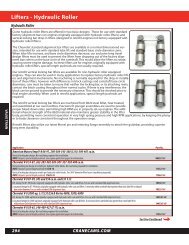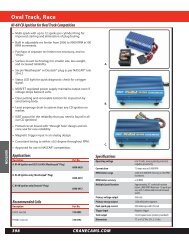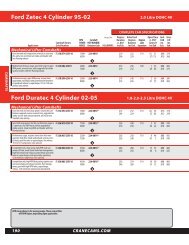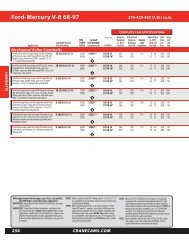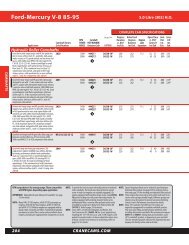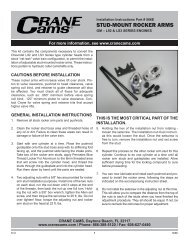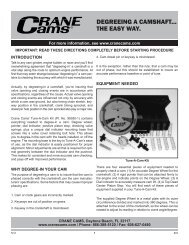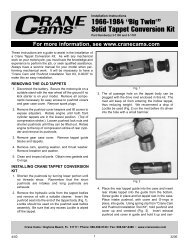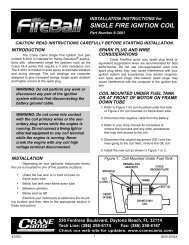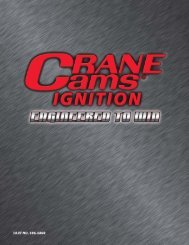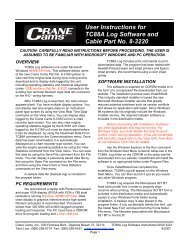2011 - Crane Cams
2011 - Crane Cams
2011 - Crane Cams
Create successful ePaper yourself
Turn your PDF publications into a flip-book with our unique Google optimized e-Paper software.
CAMSHAFTS<br />
Ford Big Block V8 Tech Tips & Notes<br />
1963-1976 352-360-390-406-410-427-428<br />
FE V8<br />
Ford’s legendary big block FE engine series provided the<br />
foundation for their passenger car, truck and performance<br />
applications for nearly two decades. Actually, this series was<br />
introduced in 1958, with the early 332-352-390 FE engines<br />
having a different camshaft and cam drive configuration<br />
than the 1963-1976 engines, preventing their direct interchangeability.<br />
The early engines did not have a camshaft<br />
thrustplate, but relied on a spring to control cam endplay.<br />
These engines can use the later camshafts if the thrustplate<br />
is installed by removing the plugs in the front of the block<br />
on either side of the cam thrust surface, and tapping the<br />
holes for the 5/16-18 attaching bolts. A later model timing<br />
chain and gear set will also have to be installed.<br />
There were also FT engines, used in truck applications.<br />
These were basically the same powerplants as the FE, but<br />
with four-ring pistons installed.<br />
For marine usage, some left hand rotation engines were<br />
produced, requiring a special camshaft and distributor drive<br />
gear.<br />
<strong>Crane</strong>’s 34 prefix designates this engine series, with a full<br />
line of camshafts and valve train components available.<br />
Hydraulic, retrofit hydraulic roller, mechanical, and mechanical<br />
roller camshafts are offered.<br />
Do not confuse the FE with the MEL engine family that<br />
Ford offered from 1958 to 1968 (383-410-430-462 cu.in.).<br />
Note that a 410 cu.in. engine was also included in that<br />
series. About the only common parts between the two<br />
engine families were the lifters and the rocker arms.<br />
FE engines were factory equipped with either hydraulic<br />
and mechanical lifter camshafts from the factory, depending<br />
upon horsepower requirements. The factory adjustable<br />
shaft mounted rocker arms have a 1.76: ratio, while the<br />
non-adjustable rockers have a 1.73:1 ratio. Lifter bores are<br />
inline, as are the valves in the cylinder heads.<br />
Oiling for the top end of the engine is directed up through<br />
passages in the block and heads, through the rocker shaft<br />
stands and shafts, then out via holes on the rocker arms.<br />
Watch for the 1965-1967 side-oiler 427 engines (and some<br />
rare 390 versions) specifically designed for mechanical lifter<br />
only usage. These blocks do not have oil galleys to supply<br />
hydraulic lifters. Therefore, hydraulic and hydraulic roller<br />
camshafts and lifters can not be used. The camshafts used<br />
in these blocks also require grooves in the second and<br />
fourth cam bearing journals (.044” wide and .035” deep,<br />
with a .022” radius) for proper oiling.<br />
Cylinder head configurations ranged from the basic lowrise,<br />
the drag race and oval track oriented high-rise, a medium-rise,<br />
and the tunnel port. All employed the same valve<br />
layout, so no camshaft changes were required. The rocker<br />
arm shaft stands varied per version, although the low-riser<br />
and the tunnel port did share the same components.<br />
A thriving aftermarket provides sufficient components to<br />
242<br />
CRANECAMS.COM<br />
build an FE from scratch. We plan on supplying camshaft<br />
and valve train components for well into the future for this<br />
icon of Ford performance.<br />
1963-1965 427 SOHC V8<br />
Developed for oval track and drag racing, the single overhead<br />
cam 427 V8 was a real show of engineering force from<br />
Ford. Although this engine was banned from use at the big<br />
ovals, drag racing certainly benefited from this escalation of<br />
factory technology. <strong>Crane</strong> was fortunate to be involved in<br />
camshaft design for these engines from the beginning, and<br />
continues to custom produce camshafts for The “cammer”.<br />
We also offer valve springs, retainers, and valve locks. Our<br />
32-prefix designates these camshafts.<br />
Based on a variant of the 427 FE side oiler block, the iron<br />
cylinder heads incorporate one camshaft per bank, actuating<br />
valves in a hemispherical combustion chamber via shaft<br />
mounted mechanical roller followers, which have an effective<br />
1.32:1 ratio. Valve lash adjustments are achieved by<br />
installing varying thickness lash caps on top of the valves.<br />
Single and dual four barrel carbureted versions were factory<br />
produced. There were a limited number of aluminum cylinder<br />
heads produced for the factory supported racers, but<br />
these did not come installed on any engines.<br />
Although never officially “factory” installed in any vehicles,<br />
connected outside contractors did obtain complete<br />
engines, and put them into Mustangs, Fairlanes, and<br />
Galaxies for sale to the racing community.<br />
This engine is also experiencing a rebirth by the aftermarket,<br />
with numerous components being offered. Expect<br />
more reproduction parts to be available in the next year.<br />
1968-1997 370-429-460 (7.5L) V8<br />
The final Ford big block family is the 385 series. Replacing<br />
the FE, newer casting techniques were used, along with<br />
more efficient cylinder heads, and a lighter valve train.<br />
<strong>Crane</strong>’s 35 prefix indicates parts specific to these engines.<br />
Hydraulic, retrofit hydraulic roller, mechanical, and mechanical<br />
roller camshafts and a full line of valve train components<br />
are offered.<br />
The lifter bores in the block are inline, but the valves are<br />
staggered in the cylinder heads for better breathing and<br />
combustion. The standard 1.73:1 ratio rocker arms are<br />
stamped steel and either stud mounted (1968-1971) or<br />
pedestal mounted (1972-1997). The rocker arms were primarily<br />
non-adjustable, with a few exceptions. The 1970-<br />
1971 Cobra Jet 429 engines had adjustable rocker arms and<br />
pushrod guideplates, while the 1970-1971 Super Cobra Jet<br />
429’s came equipped with mechanical lifter camshafts and<br />
adjustable rocker arms and guideplates.<br />
Oiling for the top end of the engine is conducted through<br />
the lifters and pushrods, providing lubrication for the rocker<br />
arm pivots and valve springs.<br />
The 1968-1971 engines are equipped with bottleneck configuration<br />
rocker arm studs. Our 99768-16 positive locking



